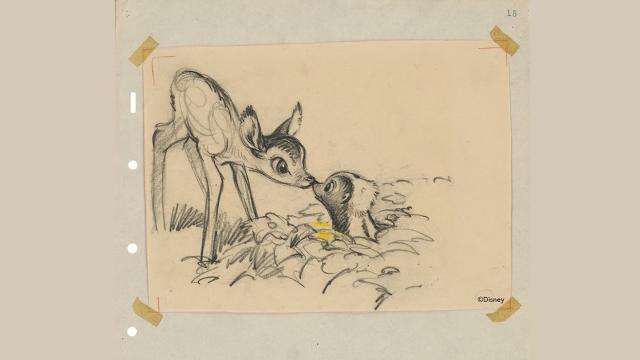
While we all remember Bambi as the wholesome Disney movie about woodland creatures (as well as that traumatic scene), it turns out the 1942 film was a watershed moment in animation.
The origins of the story weren’t fabricated from the genius mind of Walt Disney, but instead from a 1923 book Bambi, a Life in the Woods by Austrian author (and ironically, hunter) Felix Salten.
In 1933, a Metro-Goldwyn-Mayer filmmaker, Sidney Franklin, acquired the rights to the novel. Deciding it would be too difficult to create a live-action film, (imagine training all of those animals in a studio) Franklin sold the rights to Walt Disney in 1938.
Disney had just released the world’s first-ever feature-length animated film in Technicolour a year earlier. Snow White and the Seven Dwarfs was a success and as such, Disney threw themselves into creating a whole suite of feature films which are now considered to be classics. They include the dream-like Fantasia in 1940, Dumbo in 1941, followed by Bambi in 1942.
So what made Bambi different?
Studying The Subject
Firstly, let’s get some context. According to the Australian Centre for the Moving Image (ACMI), Disney created over 1 million drawings, as well as approximately 250,000 cels, (a transparent sheet where objects are drawn for hand-drawn animation), during the production of the film. Huge.
When it came to designing the intricate deers, Walt Disney famously had live fawns brought into the studio for the animators to study and even filmed zoo trips to see how less-trained animals behaved. On Snow White and the Seven Dwarfs, the supervising animator Eric Larson compared the drawings of the deers to “big sacks of flour”.
This meant that Bambi was one of the first Disney films to study the animals they were depicting on screen, resulting in more detailed drawings. The practice is still done by animators today, most notably Zootopia in 2016.
“They worked out the essence of Disney animation on Bambi, that’s continued to this day, which is animals who are caricatures of human beings and at the same time move and behave like animals,” Film historian John Culhane said, “The art of animation never was the same again.”
New Perspectives
The films animation and aesthetics were also influenced by Chinese American artist Tyrus Wong, an inbetweener (a person who illustrates the drawing between the ‘main’ drawings in an animation). While other artists were creating detailed depictions of landscapes that ended up being too busy and distracting, Wong submitted pastel drawings inspired by East Asian ink paintings.
Wong’s minimalist approach focused more on the emotion of the scenes through atmosphere and colour. According to ACMI, the influence of Wong’s art was emphasised by using a multiplane camera, which layers images on sheets of glass to provide depth.
The result was an artistic depiction of life in the forest and made audiences focus more closely on the characters.
These are just a few of the facts found in Disney’s rich past. Even more fascinating gems about Disney classics are able to be found at the Disney: The Magic of Animation exhibition at Queensland Museum.
The exhibition features a tonne of your favourite films including The Little Mermaid, Pocahontas, Frozen and of course, Bambi. It runs until January 22, 2023 and features hundreds of original sketches and artwork as well as interactive displays. Feel the magic and maybe even learn some fun facts as well.
Nab your tickets, here.
